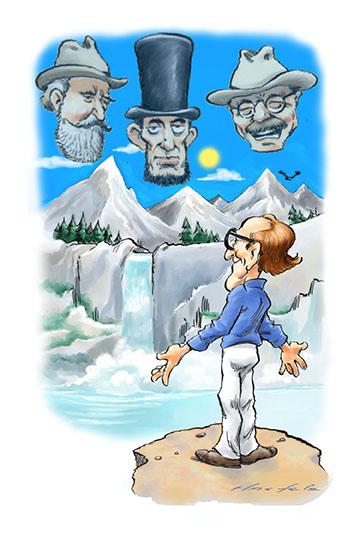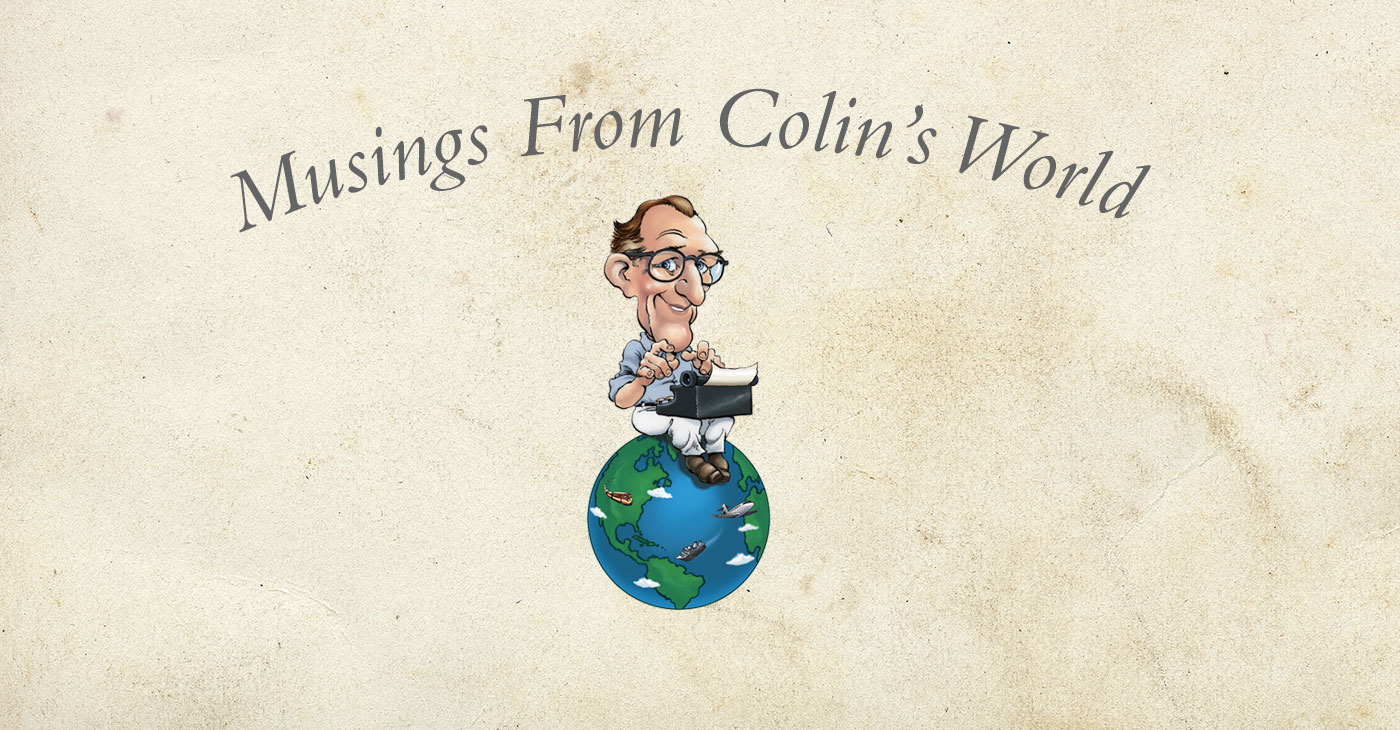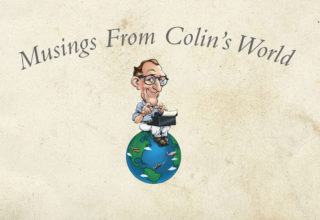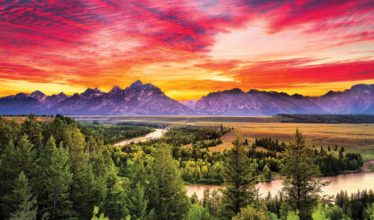Walk away quietly in any direction and taste the freedom of the mountaineer. Camp out among the grasses and gentians of glacial meadows, in craggy garden nooks full of nature’s darlings. Climb the mountains and get their good tidings. Nature’s peace will flow into you as sunshine flows into trees.
– John Muir, Our National Parks
Ken Burns and Dayton Duncan called the National Parks “America’s Best Idea” in their film series and book of that name. Even in an age of hyperbole, that’s a tall claim. Assertions stated in the absolute (THE best?) always arouse the skeptic in me. When I summon forth a list of good ideas of America, they pour over me in great numbers. But as I ponder this question, increasingly I think Burns and Duncan are really onto something.
At first I thought, “Well … maybe the National Parks are the second best idea, after the Declaration of Independence, which laid down the whole idea for this democratic republic without monarchs.”
But the Declaration of Independence was written before the establishment of the American nation. So if that’s disqualified as America’s best idea, I’m hard pressed to find a better one than the National Parks. I mean, I’m personally partial to the carburetor. And the electric light was a blockbuster. But there are ideas and there are Ideas.
When you talk about the Declaration of Independence and the National Parks, you are venturing into the sublime. These are large and far-reaching ideas. The protection of the natural wonders of our continent, to preserve them for future generations, is an idea for which we are receiving incalculable benefits today. And the value of the idea grows as the threats to our environment intensify.
 For Everyone
For Everyone
When I think about it I become almost giddy over my good fortune as the benefactor of this great legacy. And I am, you know. And so are you. That was the point. That was what most inspired Burns and Duncan to launch the ten-year project that would become The National Parks: America’s Best Idea, film and book.
“We were principally drawn to the fact that for the first time in human history, land – great sections of our natural landscape – was set aside, not for princes and kings or the very rich, but for everyone,” Burns wrote. “We liked the idea that we Americans had invented such a wonderful thing, that this idea, like our articulation of universal political freedom in the Declaration of Independence, should be so widely admired and copied throughout the world.”
Not just for the privileged few, but for everyone. All Americans are the owners of the 418 National Park sites, more than 84 million acres. The benefit goes even beyond Americans, not only because people visit them from around the world, but because the idea has been emulated by more than 100 countries.
The creators of the National Parks gave us not only the parks themselves, but an idea of such resonance that it could leap over political boundaries, language barriers and cultural contrasts and transform the world. That is powerful.
Out of the Many
Another appealing thing about the National Parks is that they were the product not of a single person but of many people. It’s as if the idea was inevitable once the idea of democracy was unleashed across the continent, as if it rose out of the land itself in the heady atmosphere of possibility of the new democratic nation.
The history of that legacy is complicated, and as Ken Burns has said, “It was always a battle.”
Certain champions of the cause stand out, such as Theodore Roosevelt, who made conservation a central cause. He created five new national parks, 51 bird sanctuaries, four national game refuges, 18 national monuments and 100 million acres of national forests. He put more than 280,000 square miles of federal land under protection, more than the state of Texas.
But Roosevelt is only one of many contributors to the legacy.
The first president to sign an act to set aside land for the people was Lincoln. The Yosemite Grant Act, proposed by California Senator John Conness, gave Yosemite Valley and Mariposa Big Tree Grove to the state of California with the stipulation that it be reserved for public use and recreation. It started as a state park, but was the prototype of the National Parks, and later became one.
It continued with the creation of Yellowstone, the first actual National Park, under President Ulysses S. Grant in 1872. The National Park Service was established by the National Park Service Organic Act, signed by President Woodrow Wilson, in 1916. It took on the responsibility of caring for the parks, which were set aside legally, but not protected.
And those major political actions rose from grassroots politics and activism.
Men of Vision
In the early 19th Century, some of young America’s greatest writers asserted that what America lacked in historical monuments such as in Europe was more than made up for by its great natural beauty.
While the new nation continued its breathless expansion across the continent, a movement took shape to protect some of the continent’s greatest natural features from exploitation and destruction by profit-seekers.
Though there was a rapacious element in the conquest of the West, there were also those who revered the great land that had been so lovingly cared for by its previous inhabitants and wanted to protect it. Nature reflects God more than any man-made cathedral, they said.
“Here is sanctity which shames our religions and reality which discredits our heroes,” wrote Ralph Waldo Emerson. “Here we find Nature to be the circumstance which dwarfs every other circumstance, and judges like a god all men that come to her. Here no history, or church, or state is interpolated on the divine sky and the immortal year.”
Henry David Thoreau called for “little oases of wildness in the desert of our civilization.” If kings in Europe had forests for themselves, he said, “Why should not we, who renounced the king’s authority, have our national preserves,” set aside “for inspiration and our own true recreation?”
The possible future without such protection was revealed by mid-19th Century.
“By the 1860s,” wrote Burns and Duncan, “the nation’s most famous natural landmark, Niagara Falls, had already been nearly ruined. Every overlook on the American side was owned by a private landowner charging a fee. Tourists could expect to be badgered – and oftentimes swindled – by the hucksters and self-appointed guides who swarmed the railroad depot and carriage stands. The atmosphere was closer to that of a carnival than a cathedral.”
Frederick Law Olmsted wrote that while California could benefit economically from tourism to the park, as did Switzerland from the Alps, there was a higher justification. Historically aristocratic classes preserved natural sites for their enjoyment, but in America, with its democratic ideals, that privilege did not have to be reserved for the wealthiest.
And certainly one of the highest in the pantheon of heroes of the National Parks was John Muir, founder of the Sierra Club, a great conservationist sometimes called “the Father of the National Parks.” He showed the power of the word to move multitudes when in the hands of someone as inspired and gifted as he was.
Through his moving descriptions and persistent calls for protection of the natural beauty in the wild areas he aroused many to a cause that was out of view of most people.
The unleashing of the democratic principle in America, the sense of ownership of each person, unleashed a flood of creativity that gave birth to countless innovations. The national parks are one of the finest manifestations of this still-evolving idea.
I am grateful for the legacy to which I am heir and I want to make most of it. With so many sites in the National Park system, I’ll never see them all. But I want to make a good showing, even just as an expression of gratitude.
Your humble reporter,
A. Colin Treadwell


